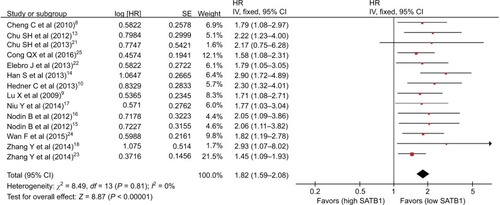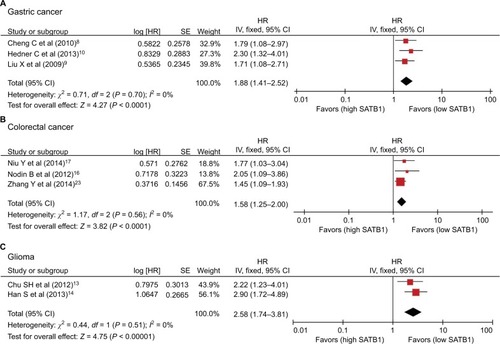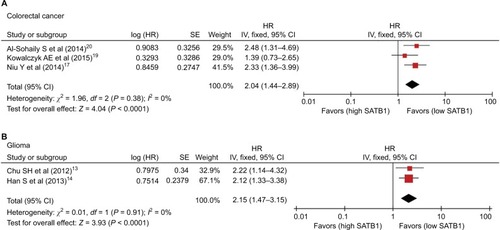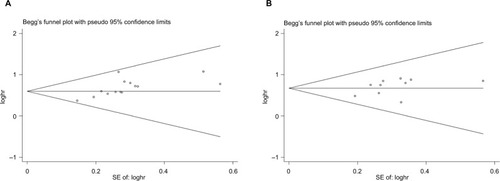Abstract
Background
Several previous studies have reported the prognostic value of special AT-rich sequence-binding protein 1 (SATB1) in solid tumors. However, these studies produced inconsistent results because of their various limitations, including small sample sizes. Here, we describe a meta-analysis based on 17 studies including 3144 patients to search for connections between SATB1 overexpression and overall survival (OS) of patients with solid tumors. Seventeen studies (n = 3144) were assessed in the meta-analysis. Both univariate and multivariate analysis for survival indicated that high SATB1 reactivity significantly predicted poor prognosis. In the multivariate analysis, the combined hazard ratio (HR) for OS was 1.82 (95% confidence interval [CI]: 1.59–2.08, P < 0.0001). The pooled HR of the univariate analysis for OS was 1.96 (95% CI: 1.65–2.34, P < 0.0001).
Methods
Studies were identified by an electronic search of PubMed, EMBASE, and Web of Science, including publications prior to April 2017. Pooled HR values for OS were aggregated and quantitatively analyzed in the meta-analysis.
Conclusion
The meta-analysis indicated that high SATB1 reactivity is significantly correlated with decreased survival in most cases of solid tumors. In addition, SATB1 shows promise as a prognostic biomarker and novel therapeutic target on the basis of its expression level in solid tumors.
Keywords:
Introduction
Epidemiological data show that 14.1 million new cancer cases and 8.2 million cancer deaths occurred in 2012 worldwide;Citation1 in other words, cancer is a leading cause of death in both more and less economically developed countries.Citation2 Although considerable improvements have been made with respect to diagnostic capabilities and therapeutic methods, patients still face poor prognosis, especially in the advanced stages of the disease.Citation3 A lack of biomarkers for early diagnosis has limited the efficacy of current therapies for patients with solid tumors. Therefore, identification of prognostic biomarkers for human solid tumors and elucidation of their molecular mechanisms are urgent priorities for improving standard diagnosis, therapy, and prognosis.
Recently, the role of special AT-rich sequence-binding protein 1 (SATB1) in tumorigenesis and tumor progression has become a focus of research. SATB1 is a cell type-specific nuclear matrix-associated protein that is predominantly expressed in thymocytes.Citation4 SATB1 serves as a gene regulator and a genome organizer, as it can form a characteristic “cage-like” network that surrounds the heterochromatin to fold chromatin into complex higher order structures. It can also provide a nuclear platform that recruits chromatin-modifying enzymes and chromatin remodeling.Citation5,Citation6 SATB1 has been reported to influence the expression of hundreds of genes, including some involved in the pathogenesis of human cancers.Citation7 These findings suggest that SATB1 may be involved in the carcinogenesis and/or progression of human malignancies. Many retrospective studies have evaluated whether SATB1 overexpression may be a prognostic factor for survival in patients with diverse types of solid tumors, including gastric cancer,Citation8–Citation10 breast cancer,Citation11,Citation12 glioma,Citation13,Citation14 epithelial ovarian cancer,Citation15 colorectal cancer,Citation16–Citation20 astrocytoma,Citation21 pancreatic cancer,Citation22 endometrial cancer,Citation23 bladder cancer,Citation24 and esophageal squamous cell carcinoma.Citation25 In addition, several studies found that the expression of SATB1 was not significantly associated with prognosis.Citation19,Citation21 Overall, the reported results are inconclusive, and no consensus has been reached. It is necessary to establish whether SATB1 expression is a prognostic marker for human solid tumors. In this study, we conducted a meta-analysis to evaluate the prognostic role of SATB1 expression in patients with solid tumors.
Methods
Literature search strategy
An electronic search of EMBASE, PubMed, and Web of Science was carried out to identify studies evaluating SATB1 expression and clinical outcome in solid tumors prior to April 2017. The search terms included ‘‘special AT-rich sequence-binding protein 1’’ or ‘‘SATB1’’ and ‘‘cancer’’ or ‘‘tumor’’ or ‘‘neoplasms’’ or ‘‘survival’’ or ‘‘prognosis’’. Only studies of solid tumors in humans were considered. A total of 982 studies were identified. The reference lists of studies were scanned for relevant reports, and further analysis was performed on articles of possible interest. Cohen’s kappa coefficient was used to determine inter-reviewer agreement. We would go all the way to reach a consensus if there was any disagreement between assessors.
Study selection
To be eligible for inclusion in this meta-analysis, a study had to meet the following criteria: 1) measure the expression of SATB1 with immunohistochemistry in the primary cancer tissue; 2) investigate the association between SATB1 and patients’ prognosis (overall survival [OS]); 3) have a follow-up period of no less than 3 years; 4) be published in the English language; and 5) be the most complete report or the most recent one, when the same author(s) published more than one on the same patient population. All candidate manuscripts were carefully read by two independent authors (Wang and Huang). In order to obtain a consensus, these two authors resolved any disagreements or conflicting results.
Data collection process and quality assessment
Two investigators (Wang and Liu) aimed to assess studies that included independently patient number, sex, median age, country, cancer type, follow-up duration, references, cutoff value for SATB1 positivity, cutoff definition, and hazard ratios (HRs) for OS with corresponding 95% confidence intervals (CIs). The OS data were acquired from tables or Kaplan-Meier curves that contained negative and positive groups for SATB1. All studies included in the meta-analysis were entire cohort studies. Each publication was scored based on the Newcastle–Ottawa scale (NOS) to identify high-quality studies.Citation26 The score ranges from 0 to 9; a study with a score ≥6 was considered to be methodologically sound. A consensus NOS score was reached for each publication by discussion.
Statistical analysis
Data were acquired from the original articles and analyzed using the RevMan 5.3 software. The Mantel-Haenszel random-effects model was used for the weighted and pooled HR estimates, while Cochran’s Q and I2 were used for the heterogeneity statistics.Citation27,Citation28 As recommended by the Cochrane Handbook for Systematic Reviews of Interventions, differences appearing in the subgroups were assessed. A difference was considered statistically significant if two-sided P<0.05. Publication bias was estimated qualitatively using funnel plots with the standard error and evaluated by Begg’s and Egger’s tests.Citation29
Results
Search results and study characteristics
Seventeen studies involving a total of 3144 patients were used for the meta-analysis (). The included studies are summarized in . Five studies evaluated colorectal cancer,Citation16–Citation20 three studies evaluated gastric cancer,Citation8–Citation10 two studies focused on breast cancerCitation11,Citation12 and glioma,Citation13,Citation14 and one each evaluated epithelial ovarian cancer,Citation15 astrocytoma,Citation21 pancreatic cancer,Citation22 endometrial cancer,Citation23 bladder cancer,Citation24 and esophageal squamous cell carcinoma.Citation25 The studies were performed in five countries (People’s Republic of China, Germany, Poland, Australia, and Sweden) and published prior to April 2017.
Table 1 Characteristics of the included studies
Association of SATB1 with OS
There were 14 studies that reported OS data with multivariate analysis. The relevant results showed that SATB1 overexpression in human tumor tissues was associated with a decrease in survival among solid tumor patients (HR = 1.82; 95% CI 1.59–2.08, P < 0.00001) (). There was no evidence of heterogeneity among the 14 studies mentioned (P = 0.81, I2 = 0 %). Pooled HRs for OS according to subgroup analysis of the included studies are shown in . We further performed a subgroup analysis to assess OS data for different types of cancer using univariate analysis. Three reports provided OS data for gastric cancer and colorectal cancer, and two for glioma. A stratified analysis on solid tumor type showed that SATB1 overexpression was connected with negative clinical outcomes in gastric cancer (HR = 1.88; 95% CI 1.41–2.52, P < 0.0001) (), colorectal cancer (HR = 1.58; 95% CI 1.25–2.00, P < 0.0001) (), and glioma (HR = 2.58; 95% CI 1.74–3.81, P < 0.00001) (). There were 10 studies reporting OS data with univariate analysis. Relevant results showed that SATB1 overexpression in human tumor tissues was related to a decrease in survival among solid tumor patients (HR = 1.96; 95% CI 1.65–2.34, P < 0.00001) (). Among the 14 studies involved, there was no significant heterogeneity (P = 0.91, I2 = 0%). We further conducted a subgroup analysis to assess OS data for different types of cancer with multivariate analysis. Three reports provided OS data for colorectal cancer and two studies for glioma. A stratified analysis of solid tumor type found that SATB1 overexpression was connected with negative clinical outcomes in colorectal cancer (HR = 2.04; 95% CI 1.44–2.89, P < 0.0001) (), and glioma (HR = 2.15; 95% CI 1.47–3.15, P < 0.00001) ().
Table 2 Pooled HR for OS according to subgroup analysis
Figure 2 Meta-analysis of the association between SATB1 and OS (multivariate analysis) in patients with solid tumors.
Abbreviations: CI, confidence interval; HR, hazard ratio; IV, inverse variance; OS, overall survival; SATB1, special AT-rich sequence-binding protein 1; SE, standard error.

Figure 3 Subgroup analysis of OS (multivariate analysis) by SATB1 expression in various tumor types. (A) Gastric cancer; (B) colorectal cancer; and (C) glioma.
Abbreviations: CI, confidence interval; IV, inverse variance; OS, overall survival; SATB1, special AT-rich sequence-binding protein 1; SE, standard error.

Figure 4 Meta-analysis of the association between SATB1 and OS (univariate analysis) in patients with solid tumors.
Abbreviations: CI, confidence interval; IV, inverse variance; OS, overall survival; SATB1, special AT-rich sequence-binding protein 1; SE, standard error.

Figure 5 Subgroup analysis of OS (univariate analysis) by SATB1 expression in various tumor types. (A) Colorectal cancer and (B) glioma.
Abbreviations: CI, confidence interval; HR, hazard ratio; IV, inverse variance; OS, overall survival; SATB1, special AT-rich sequence-binding protein 1; SE, standard error.

Publication bias
The funnel plots showed no evidence of publication bias in the studies of either outcome. No evidence for significant publication bias was found for OS with multivariate analysis () or univariate analysis ().
Discussion
Over the past several decades, much research has focused on identifying novel prognostic markers in order to advance therapy and outcomes by informing clinical decision making. The prognostic significance of SATB1 expression has been investigated in a wide range of cancers. Here, we aimed to summarize and evaluate the findings of published studies and extract valuable information that can be used in clinical decision-making regarding human solid tumors.
This meta-analysis was the first systematic review to investigate in depth the relationship between SATB1 overexpression and OS of patients with solid tumors. Survival data for 3144 solid tumor patients in 17 different studies were systematically analyzed. The meta-analysis indicated that the overexpression of SATB1 could be used as a biomarker of poor prognosis in human with solid tumors, with similar OS results given by the multivariate and the univariate analysis. Regarding solid tumors of different tissues, high SATB1 expression was relevant to poor OS in gastric cancer, colorectal carcinoma, and glioma. Similarly, increased SATB1 expression was associated with poor survival in solid tumors. Further studies are required to verify the potential mechanism and impact of SATB1 in the pathogenesis of human solid tumors, in addition to its prognostic value.
There are several crucial implications of this meta-analysis. First, SATB1 expression is associated with adverse outcomes in various human solid tumors, indicating that SATB1 may be of use as a new therapeutic target. Second, in a subgroup of tumors, tumor tissues with high SATB1 expression were shown to have worse OS, including gastric cancer, colorectal carcinoma, and glioma. Overall, this study highlights SATB1 as a valuable prognostic biomarker with potential clinical applications.
However, this meta-analysis had some deficiencies and limitations. First, there was a risk of publication bias, as some studies with small sample sizes or negative results may not have been published. Second, there may be inconsistent data in the included reports, as they used different cutoff values and analysis methods for evaluating SATB1 overexpression. Finally, there may be a certain publication bias within some of the included studies, as any negative results are less likely to have been reported.
Conclusion
In general, this meta-analysis makes it clear that SATB1 overexpression is related to poor OS in the case of most human solid tumors. It also suggests that SATB1 is both a promising prognostic indicator and a potential therapeutic target for human solid tumors.
Acknowledgments
This study was supported by grants from the Medical Innovations Topic in Fujian Province (no. 2016-CXB-8, 2012-CXB-29), the Science and Technology Project of Natural Science Foundation of Fujian Province (no. 2016J01639), and the Project of Xiamen Scientific and Technological Plan (nos. 3502Z20134011 and 3502Z20174023).
Disclosure
The authors report no conflicts of interest in this work.
References
- TorreLABrayFSiegelRLFerlayJLortet-TieulentJJemalAGlobal cancer statistics, 2012CA Cancer J Clin20156528710825651787
- FerlayJSoerjomataramIDikshitRCancer incidence and mortality worldwide: sources, methods and major patterns in GLOBOCAN 2012Int J Cancer20151365E359E38625220842
- MacdonaldJSGastric cancer–new therapeutic optionsN Engl J Med20063551767716822999
- DickinsonLAJohTKohwiYKohwi-ShigematsuTA tissue-specific MAR/SAR DNA-binding protein with unusual binding site recognitionCell19927046316451505028
- GalandeSPurbeyPKNotaniDKumarPPThe third dimension of gene regulation: organization of dynamic chromatin loopscape by SATB1Curr Opin Genet Dev200717540841417913490
- PurbeyPKSinghSNotaniDKumarPPLimayeASGalandeSAcetylation-dependent interaction of SATB1 and CtBP1 mediates transcriptional repression by SATB1Mol Cell Biol20092951321133719103759
- HanHJRussoJKohwiYKohwi-ShigematsuTSATB1 reprogrammes gene expression to promote breast tumour growth and metastasisNature2008452718418719318337816
- ChengCLuXWangGExpression of SATB1 and heparanase in gastric cancer and its relationship to clinicopathologic featuresAPMIS20101181185586320955458
- LuXChengCZhuSSATB1 is an independent prognostic marker for gastric cancer in a Chinese populationOncol Rep201024498198720811679
- HednerCGaberAKorkocicDSATB1 is an independent prognostic factor in radically resected upper gastrointestinal tract adenocarcinomaVirchows Arch2014465664965925326863
- HankerLCKarnTMavrova-RisteskaLSATB1 gene expression and breast cancer prognosisBreast201120430931320980149
- LiuXZhengYQiaoCExpression of SATB1 and HER2 in breast cancer and the correlations with clinicopathologic characteristicsDiagn Pathol2015105025956130
- ChuSHMaYBFengDFUpregulation of SATB1 is associated with the development and progression of gliomaJ Transl Med20121014922839214
- HanSXiaJQinXHanSWuAPhosphorylated SATB1 is associated with the progression and prognosis of gliomaCell Death Dis20134e90124176859
- NodinBHednerCUhlénMJirströmKExpression of the global regulator SATB1 is an independent factor of poor prognosis in high grade epithelial ovarian cancerJ Ovarian Res2012512422992394
- NodinBJohannessonHWangefjordSMolecular correlates and prognostic significance of SATB1 expression in colorectal cancerDiagn Pathol2012711522935204
- NiuYWangLChengCIncreased expressions of SATB1 and S100A4 are associated with poor prognosis in human colorectal carcinomaAPMIS201512329310125257341
- ZhangYTianXJiHExpression of SATB1 promotes the growth and metastasis of colorectal cancerPLoS One201496e10041324971456
- KowalczykAEGodlewskiJKrazinskiBEDivergent expression patterns of SATB1 mRNA and SATB1 protein in colorectal cancer and normal tissuesTumour Biol20153664441445225874491
- Al-SohailySHendersonCSelingerCLoss of special AT-rich sequence-binding protein 1 (SATB1) predicts poor survival in patients with colorectal cancerHistopathology201465215516324118100
- ChuSHMaYBFengDFRelationship between SATB1 expression and prognosis in astrocytomaJ Clin Neurosci201320454354723317753
- ElebroJHebyMGaberAPrognostic and treatment predictive significance of SATB1 and SATB2 expression in pancreatic and periampullary adenocarcinomaJ Transl Med20141228925323550
- ZhangYWangLLiuYOverexpression of special AT-rich sequence-binding protein 1 in endometrial cancer: a clinicopathologic studyInt J Gynecol Cancer201525141125347096
- WanFChengCWangZSATB1 overexpression regulates the development and progression in bladder cancer through EMTPLoS One2015102e011751825706386
- CongQXZhangHSunSXLiHFWangYJianSPilot study special AT-rich sequence-binding protein 1 investigating as a potential biomarker for esophageal squamous cell carcinomaDis Esophagus201629662162625951709
- StangACritical evaluation of the Newcastle-Ottawa scale for the assessment of the quality of nonrandomized studies in meta-analysesEur J Epidemiol201025960360520652370
- HigginsJPThompsonSGDeeksJJAltmanDGMeasuring inconsistency in meta-analysesBMJ2003327741455756012958120
- DickersinKBerlinJAMeta-analysis: state-of-the-scienceEpidemiol Rev1992141541761289110
- SterneJAEggerMFunnel plots for detecting bias in meta-analysis: guidelines on choice of axisJ Clin Epidemiol200154101046105511576817


